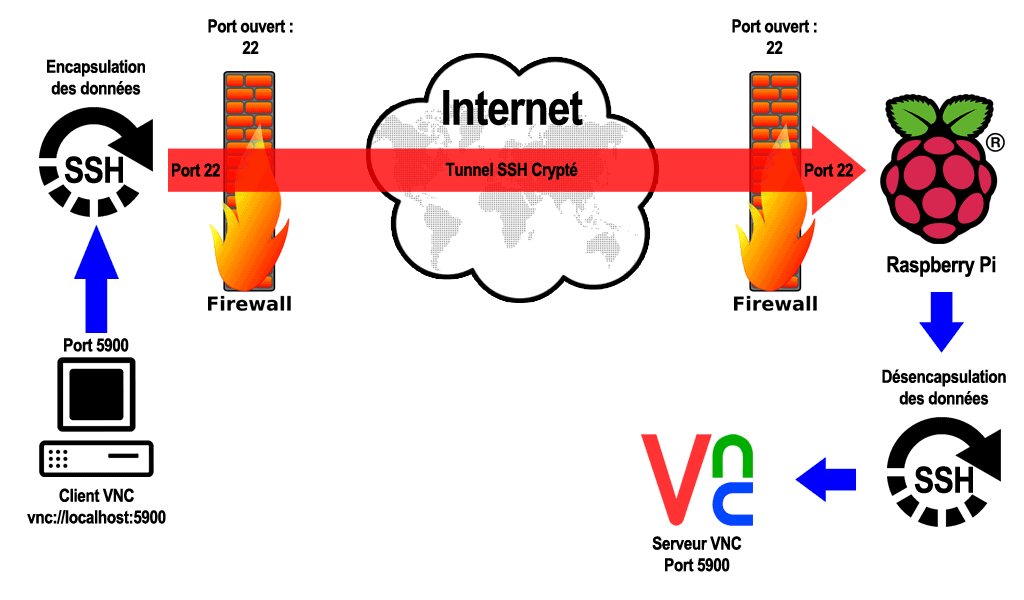

Process: 444 ExecStart=/etc/init.d/connectoverwatch start (code=exited, status=0/SUCCESS)ĬGroup: /system.slice/rvice Loaded: loaded (/etc/init.d/connectoverwatch generated vendor preset: enabled)Īctive: active (running) since Sat 00:53:30 PST 42min ago Now I could start and stop the service and it would start with startup.
#Ssh tunnel raspberry pi code
Then, I borrowed some code from and made the script into a service named connectoverwatch. Tmux send-keys -t $n 'ssh -vvv -Nf -R 7070:localhost:22 -p xx & ' C-m The IP address and SSH port of my AWS instance is redacted for security. I first created a bash script that starts a TMUX session and runs creates the reverse SSH tunnel from it. Start as a service on boot, run in the background and allow checking status On the local machine Here aws-ssh-keys.pem is the ssh key file downloaded from AWS. On local machine ssh-keygenĬat aws-ssh-key.pem > ~/.ssh/authorized_keys I first added the SSH keys to the AWS instance on my local machine. This means I will need to SSH into the remote host and then SSH into the local machine.

What we see above is how a simple reverse SSH tunnel is set up. This will be connected to the local machine(Raspberry Pi). ssh -p 7070īasically, we are creating an SSH tunnel from the remote machine(AWS instance) to itself(localhost) on port 7070. Tcp 0 0 127.0.0.1:7070 0.0.0.0:* LISTEN 1621/sshd: can SSH into the local machine from the remote machine as below. Once the tunnel is created,You can see the remote machine listening on TCP port 7070 with netstat run on the remote machine. The port 22 at the end is the local port (default SSH port) to which connections will be forwarded from port 7070 on the remote host. The next localhost refers to the local machine from which the tunnel is created. The port 7070 is the TCP port on the remote machine which will listen for SSH connections to the local machine. We skipped this in the example because it is by default localhost. The first localhost is the address on the remote machine where the remote entrypoint should be. In our case this would be localhost:7070:localhost:22. The exact syntax of using this is -R port:host:hostport. Here we used the -R flag to specify remote entry point. ssh -R 7070:localhost:22 examine the above example. Here is how you can create a reverse ssh tunnel from the local machine to the remote machine. Through this connection, you will be able to SSH from the remote machine to the local machine even though the local machine may be behind a NAT device. Essentially, you are mapping a socket(combination of an IP address and a port number) on the remote machine to a socket on the local machine. The basics of how a reverse SSH tunnel works is this.īy creating a reverse SSH tunnel from the local machine(Raspberry pi at home) to the middleman server(AWS instance), you are creating a tunnel for the middle man server to connect back to the local machine.
#Ssh tunnel raspberry pi for free
I used an Ubuntu 18.04 image that was eligible for free tier usage in AWS. If you are new to AWS, you can basically setup an instance for free (there are caveats, read about it here). For this, I have setup an instance on AWS. To access your home server from anywhere in the world, you would need a middleman SSH server on the cloud. Since I ran into some issues with this, I decided to go a different route which this article is about. I will write a post about this later and link it here. To get around this, I was using a system where I would send an email to a gmail account set up specifically for the Pi and the Pi would respond back with the ngrok URL. The problem with this was that ngrok would give me a different URL every time the Pi reboots. Earlier I was using an ngrok tunnel for this. Without a dedicated public IP address this often proved a difficult task. I may at times find myself in a need to log into the Pi while not at home to check up on things. I have a raspberry pi running at home taking care of some home networking/automation stuff.
#Ssh tunnel raspberry pi how to
How to SSH into a Raspberry Pi running at home from anywhere in the world without a dedicated public IP The requirement


 0 kommentar(er)
0 kommentar(er)
